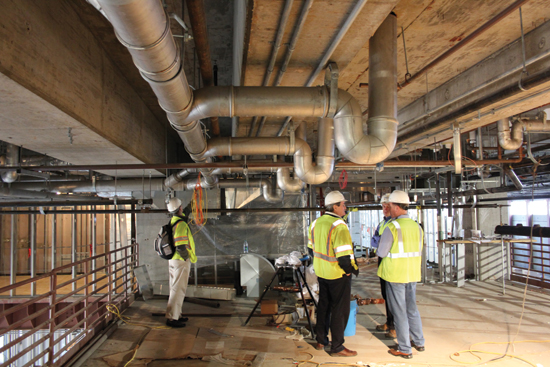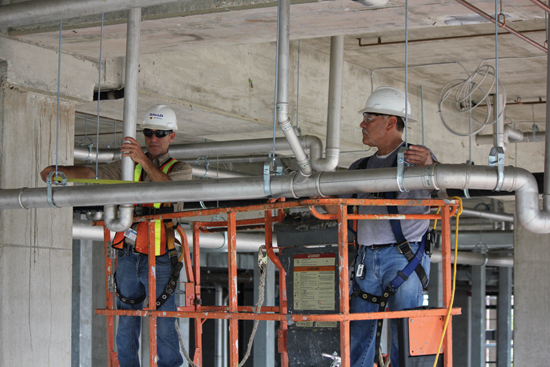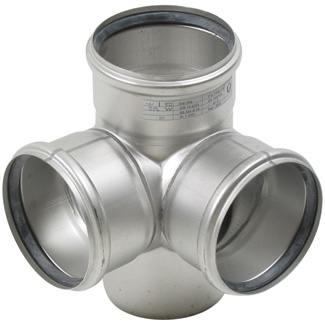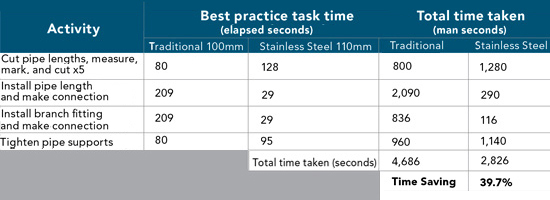Choosing Stainless Steel Drains for Caustic Environments
Stainless steel drainage systems provide greater longevity for sustainable wastewater solutions.
![]() Continuing Education
Continuing Education
Use the following learning objectives to focus your study while reading this month’s Continuing Education article.
Learning Objectives - After reading this article, you will be able to:
- Compare the life-cycle benefits of stainless steel drains, channels, and piping with other types of materials as a durable solution for areas with caustic wastewater.
- Evaluate transportation cost reductions by choosing sustainable stainless steel drainage systems that weigh only one-third the weight of alternative cast-iron systems.
- Identify a variety of wastewater applications and the grades of steel that can be selected to improve longevity in high temperature drainage systems.
- List the unique properties, including high recycled content and recyclability, and simplified labor costs, of stainless steel for use in drainage systems to help meet green building ratings criteria.
Sludge, grease, acids, high temperatures—a caustic waste stream is a challenging problem for any drainage system. The control of wastewater in buildings from airports to hospitals and commercial kitchens can lead to costly retrofits. Handling the harsh environment in drainage systems may be one of the last items on the specification list, but critical to the success of many projects.
Commercial codes for wastewater drainage require that these systems meet standards for both black and grey water. Industry standards for highly corrosive environments require the control of effluents that can be very hot and/or acidic. Higher concentrations of cleaning fluids, higher temperatures for manufacturing and cleaning are making the task of removing and treating waste a difficult proposition. In the past, engineers have chosen cast iron as the only solution to wastewater problems. Today, some engineers are choosing stainless steel drainage systems, instead of cast iron, because stainless provides higher performance values for meeting the requirements of caustic waste and it provides much greater longevity over the lifetime of a facility.
In addition, the advantage of stainless steel is that it is aesthetically pleasing. As more designers are opening up areas to view by the public in restaurants, hospital kitchens, and even manufacturing plants, drainage is becoming a design element. Sleek, stainless steel, ADA-compliant drains, fittings, and fixtures are also evident in multifamily housing, where the rate of investment requires durability.
To meet green building targets, engineers are selecting materials that have green properties. Stainless steel is one of these choices as most stainless steel contains approximately 60 percent recycled content. Because it is lightweight in comparison to cast iron, the selection of stainless steel reduces transportation costs and therefore carbon emissions.
With all of these considerations, the advantages of stainless steel drainage systems make them the best choice for aesthetics, durability, and sustainability for any project. These systems outperform cast iron or other alternatives in almost every category. The choice of drainage system is often based first on the direct costs of the system. However, calculations show that when you include costs of installation, labor, and product-life expectancy, a stainless steel drainage system is more cost-effective in the end.
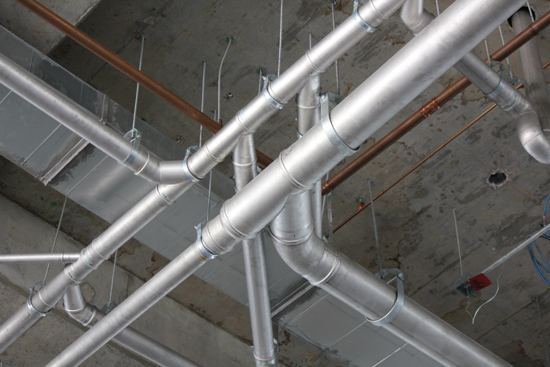 |
Stainless steel pipes and drainage systems can provide a sustainable, attractive, and durable solution when requiring a plumbing system that can withstand high temperatures. Photo courtesy of BLÜCHER |
Benefits of Stainless Steel Drainage Systems
Stainless steel drainage systems have functional and aesthetic benefits as well as provide superior safety and durability. Stainless steel drainage systems meet or exceed all of the required codes for effluent transport. Stainless steel is a 100 percent recyclable and non-toxic material and provides an impressively long product life, making it an environmentally friendly and maintenance friendly choice.
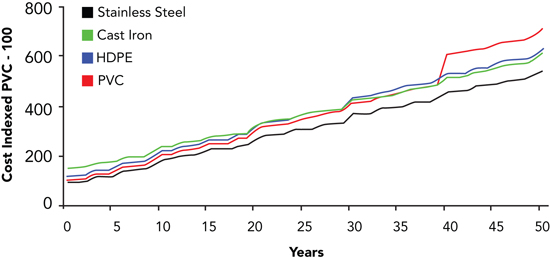 |
Whole life cost assessment comparisons. Source: BLÜCHER |
Functionally, stainless steel systems provide good flow characteristics which is important when considering a material that needs to transport fats and greases. Stainless steel has a unique smooth surface that guarantees excellent flow capacity. Stainless steel has a greater tolerance for the transportation of fat, which can quickly congeal and clog plumbing lines. The addition of an electric heat element to pipes allows for an even easier transport of grease through the pipelines. Due to smooth, hard, nonporous surfaces, bacterial growth is greatly reduced in stainless steel drainage systems. Using this material to transport kitchen wastes provides optimal performance for difficult projects.
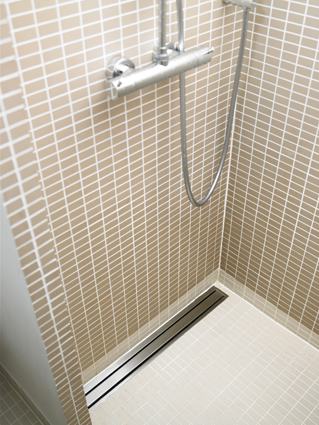 |
Stainless steel channel drains are both an attractive and hygienic solution for hospital and hotel settings. Photo courtesy of BLÜCHER |
Stainless steel drainage systems are easy to install and require minimal maintenance. The low weight of the smaller steel products means that the weight of a drainage system can be reduced by more than 20 percent compared to cast iron. Push fit connections are also lighter in weight, reducing labor and installation expenses.
Stainless steel is resistant to corrosion, fire, chemical abrasions, deformation, and thermal stress. Stainless steel can withstand a high degree of vibration, and it functions within a wide scale of temperatures. Stainless steel is classified as a fire-resistant material and some alloys with chromium content of at least 18 percent can withstand temperatures over 800°C. The high temperature strength of stainless steel is referred to as “creep strength” or the ability to resist distortion or flaking over time.1 This means that stainless steel provides greater assurance than cast iron piping, which collects rust flakes that can constrict flow over time.
Stainless steel has a greater life expectancy than cast iron in commercial and industrial settings. In comparison to cast iron, a typical stainless steel drainage system will not corrode when used with highly acidic environments. Stainless steel can meet the requirements of high temperatures whether from boilers, grease, or chemical waste.
Stainless steel is strong. Stainless steel offers a combination of low weight and high strength. The advantages of this property means that drainage lines can be hung from ceilings of commercial buildings with longer runs using fewer connections. Stainless steel alloys used in plumbing have ratings from 73,000 pounds per square inch tensile strength to 90,000 pounds per square inch tensile strength. Because this material is strong, it can be placed above or below ground. Even during installation, the advantage of using strong stainless steel drains and drain components is that they can be subjected to heavy construction equipment and vibrations. Stainless steel grates can be specified to provide strong surfaces during and after construction to support heavy equipment.
Easy to clean and constructed of non-toxic materials, stainless steel meets the strict hygiene and cleaning requirements for many settings, from restaurants to hospitals. Stainless steel drainage systems are the choice for buildings that are designed to last and for facilities that cannot be easily closed for the replacement and/or maintenance of a clogged cast iron drainpipe.
Besides prisons, other applications for stainless steel drainage systems include some of the most caustic drainage environments as well as the most visible. Obviously durable drains are required in industrial areas; however, equally difficult applications include commercial kitchens.
The benefits of stainless steel can be applied to numerous building types. Medical facilities and laboratories require drainage systems that are impervious to high concentrations of chemicals as well as biological waste. They require drainage systems, particularly those parts exposed to patients to be easily cleaned and resistant to bacteria. The smooth, nonporous surface of stainless steel components makes them easy to maintain.
In the hospitality market and for multifamily housing, stainless steel adds durability and an aesthetic advantage. Hotels and resorts require systems that are both dependable and visually appealing. They must also meet all codes for handicapped accessibility. Stainless steel shower drains are both attractive and strong.
The Seattle-Tacoma International Airport provides another example of how stainless steel is being used in the Northwest. Cleaning fluids, grease, hot and cold liquids, are just a few of the problematic wastes from an airport concession stand that with a plumbing system failure will lead to large inconvenient closures and replacement costs. There are approximately fifty restaurants at the airport. The waste stream includes soda, syrup, juice, corrosive liquids and fryer fat. Within four or five years, the cast-iron piping that the airport had been using was replaced due to corrosion. As in the case study for Pike Place Market, the installation had to be completed without shutting down the airport. Stainless steel systems provided a means to isolate each vendor and complete the project without a complete airport shutdown.
Supermarkets, restaurants, airports are all public spaces requiring serious drainage system solutions. The replacement cost of a broken or clogged drain is not just the cost of renovation. Plumbing drains are buried in floors and walls, and replacement usually means closing a business for a number of days.
Marine drains, such as those on cruise ships and fishing vessels require drains that are non-corrosive and can deal with harsh ocean salt water. Stainless steel marine grates and drains can be part of either a renovation of an existing drainage system or specified for a new installation.
| Stainless Steel Drainage System Chosen for New Orleans Prison | ||||
The New Orleans Parish Prison is a large complex built to replace outdated facilities decimated by Hurricane Katrina. This cluster of buildings includes new prison housing, an intake and processing center, a three-story administration building and a new 163,885-square-foot kitchen/warehouse building. The contractor for these facilities included a number of architectural and engineering firms, including the design team from Huseman & Associates who were responsible for the design of the building’s electrical, mechanical, plumbing and fire protection systems including the waste drainage system for this facility. The team knew that it would not be an easy place to replace drains and pipes in the future. They wanted a solution that would last the life of the facility. Jamey Logrande, vice president and senior project manager with Louisiana-based Huseman & Associates, reviewed the design criteria for the system. At the initiation of this project, there were limited solutions for this plumbing system. The harsh nature of this environment, high temperatures, sugars, grease, and cleaning fluids required a durable material. The extensive waste system in this facility included 8,000 lineal feet of drainage piping as well as piping used to transport high temperature soups and stews to packaging equipment. When interviewed in 2012, Logrande stated, “We knew of the need for massive dumping of high-temp fluid on a regular basis and, with very expensive, very temperature-sensitive food storage spaces below the kitchen, we knew there’d be no room for error,” Logrande says. “We couldn’t afford a leak; the result would be catastrophic.”2 Logrande investigated alternatives for this project choosing stainless steel as the material to use in this project a new type of drainage system that had been successful in Europe for many years. He was able to work with the contractor and the supplier to facilitate the installation of this unique product. Stainless steel was chosen because of its lightness, strength and longevity. With very low porosity, bacterial growth is reduced in these drainage systems. The long runs and heavy loads that were drained from the kitchen meant that choosing a material with three times the strength of cast iron meant a more efficient use of materials. The installation also included the use of push-fit connections that reduced construction time and saved labor cost. The use of stainless steel over cast iron meant the reduction of the weight of the system by 20 percent adding to the ease of installation. Completed in late 2013, the facility was designed to feed and store meals for a large prison population. Huseman & Associates won a 2009-2010 regional ASHRAE technology award for this project.
|
| Seattle’s Farmers Market Updates Drainage to Stainless Steel | ||
Pike Place Public Market is located in the heart of Seattle, with views of Puget Sound. This outdoor/indoor market is over 100 years old and one of the first farmer’s markets. Over 10 million visitors a year visit this historic sight to select fresh fish, drink Seattle’s coffee, and eat from the many food carts and restaurants in the area. From French fries to fried chicken, the challenge for the ancient cast iron system became too much for it to handle. To make matters worse, previous repairs were makeshift and used PVC in place of the cast iron and the entire system was incompatible. In 2008, work began on replacing the ancient drainage. Pike Place is open 362 days a year and for the small businesses, closing for repairs was not an option. With over 30 restaurants, many opening at dawn and closing for last call after midnight, there was only after hours in the night for project construction. The plumbing contractor, MacDonald Miller Facility Solutions isolated each vendor in the market and used the flexibility and ease of installation of stainless steel to install over 7,600 linear feet of piping in short shifts. In a four-hour shift, the plumbers removed the old cast-iron or PVC piping, installed the new stainless steel pipe and tested it before moving on to the next area of the market. Unlike other types of piping, the installers worked from one end to the final connections using easy to assemble push-fit connections. MacDonald Miller Facility Solutions provides mechanical engineering, design-build construction, custom metal fabrication, building system service and maintenance. Plumbing superintendant, Kevin Vincent reported that they have had no call-backs to the project in the May 2013 PM Engineering magazine summarizing “As far as we can tell, grease oil and fat don’t stick to it.”3 |
Choosing Drainage System Components
Some of the basic components of drainage systems are drains, channels, pipes, and fittings. All of these components, many of which are visible in public spaces, can be selected in stainless steel. Although a small part of a large system, more durable selections of each part of the drainage system provides insurance that the entire system will operate for many years as intended.
Drains and Channels
Drains are the most visible component of a drainage system and one that is often subject to heavy traffic and the first flush of any waste component. Floor drains are specified for light- or heavy-weight loading and for light- to heavy-duty flows of waste products. Stainless steel drains should be specified to meet the American Steel and Iron Institute (AISI) 304 or grade AISI 316 depending on location. AISI 304 grades are used both for indoor and outdoor applications. AISI 316 grades are specified for locations that are highly corrosive. These include industrial and marine applications. According to this standard, there must be no significant change and less than 5 percent rust stains in the drain material after 50 years of use.
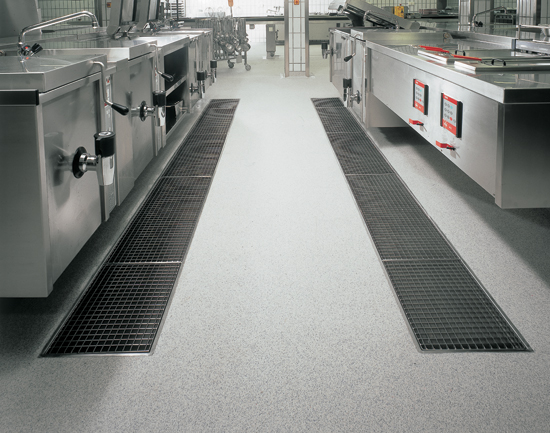 |
Stainless steel channels can be installed on most flooring types and work well in kitchens where there can be a high concentration of fats, chemicals, and high heat. Photo courtesy of BLÜCHER |
Durable sanitary stainless steel drains can be applied to most flooring types. Details are available from most manufacturers for installations on concrete, tile, vinyl and epoxy flooring. Drains can be placed on vertical or horizontal outlets. They can also be adjustable to meet grade or allow for inconsistencies between the drawings and the actual installation. With tile flooring, stainless steel drains, both round and square drains can be installed with sheet and liquid membranes and leveling compounds.
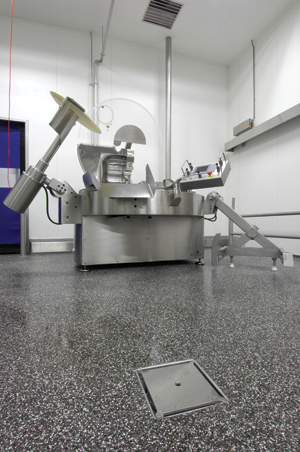 |
|
Photo courtesy of BLÜCHER |
Additional components may need to be specified as part of the drain such as a surface membrane clamp when installing drains where there is rubberized flooring. When the project is located where there will be a lot of weight placed on a drain, the design professional should also evaluate and specify a reinforced frame for the grate or drain.
The following is a list of just a few of these unique situations and the drains that can be specified to meet the challenge.
• Sanitary floor drains
• Channel drains
• Gastight industrial drains
• Hub drains used for condensate drainage of refrigeration units.
• Marine drains
Pre-sloped shower channel drains, trench drains, and kitchen channels for commercial and industrial applications can be selected in hygienic stainless steel for both standard and customized solutions. These pre-sloped longitudinal drains have a cross fall and provide a sleek and attractive solution particularly for visible areas in medical facilities, hotels, resorts, commercial kitchens, and some industrial locations.
Marine drains are required to withstand some of the harshest waste environments. The location of these drains may require installations on aluminum, plate steel, wood, or resin. Whether specifying a drain, grate for a new, or replacement drain, stainless steel provides the flexibility as a material to be manufactured for all of these unique marine applications.
Drain accessories may include sediment baskets, P-traps, and sand buckets. Drains may require floor clean outs and these can be designed for vacuum handles or nipple pullouts depending on the waste requirements. Vacuum handles allow for tamper proof drains and cleanouts in sensitive environments like test laboratories. Knowing the application will allow the design professional to choose a complete system, one that fits and is easy to install and maintain.
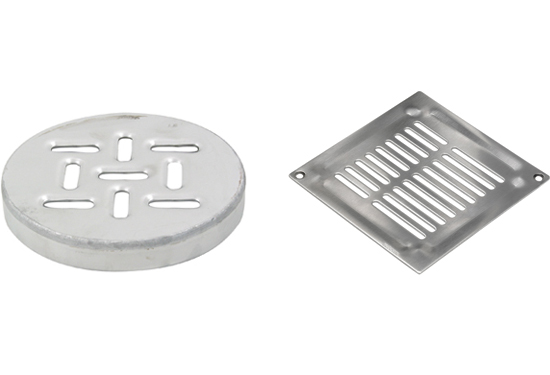 |
Stainless steel drains can be selected to have patterns or custom designs. Photos courtesy of BLÜCHER |
Stainless steel drains can also be chosen for aesthetics for hotel and residential projects, modular drains can fit within any installation. The latest in drain design includes drains with patterns both historic and modern. Some stainless steel drains can be customized with words or patterns providing an opportunity for commercial branding for the client. For example, branding the drains in a stadium with the home team's logo or on a cruise ship with the company's name can add a unique touch. Specifying for a unique location rather than using an old specification from the last project, will mean fewer change orders and greater success on any project.
Pipes and Fittings
Above and below ground pipes and fittings specified in stainless steel are lightweight and fire resistant. They are interchangeable between vacuum and gravity systems. Options for stainless steel piping includes a range of pipe hangers, access pipe forms with hinged doors, a range of sealing rings for special applications. Both manual and electric pipe cutting tools can be used with stainless steel pipe systems. Push-fit sealing rings make installation easier in any application. Standard diameters and standard lengths with an extensive range of fittings are available. Stainless steel pipes and fittings should meet AISI304/EN 1.4301 or AISI316L/EN 1.4404 depending on project type and waste requirements.
| Labor Savings With Stainless Steel Fittings | |||
A new installation of a stainless steel push-fit drainage system allowed a British contractor to save 11 percent over using more traditional cast-iron. In addition, the installation labor costs were reduced by 40 percent over the traditional methods when studied by a British research institution. The use of stainless steel provided high corrosion resistance, requiring minimal maintenance. The lighter stainless steel system was easier to install. The challenge to the contractor was to provide the drainage system for a new eight-story office building in Manchester, UK. A lightweight, stainless steel, push-fit pipe system with a rubber, EPDM seal was chosen by the contractor because of the ease of installation and the variety of sizes and lengths suitable for this high-rise office. Some of the advantages of using this system included: • Many lengths of standard pre-cut pipe reducing the need for field cutting. • Incorporation of one push-fit connection for each pipe length. • Ease of handling as stainless steel pipework is one-third the weight of lightweight cast iron. • Protected joints with an overlap of 40 mm or 1.5 inches of metal-to-metal cover removing the need for separate ‘earthing’ straps between joints. • Ability to install above, below ground, and in many caustic environments. • Suitability for installation in both gravity and siphonic soil, and for waste and rainwater drainage systems. • Ability to handle temperatures up to 230 degrees Fahrenheit. The system was simple to install and the manufacturer provided free training to the contractor to assure that they used the specialized cutting and beveling tools properly to increase the efficiency of installation. Connections are sprayed with lubricant before the pipe is inserted into the fitting and allowance for expansion is recommended when inserting the pipe into the fittings. The Building Services Research and Information Association (BSRIA) evaluated and compared this installation providing data on cost savings in 2003. Founded in 1955, BSRIA provides testing, research and consultation to clients in the construction and building services. For this case study, BSRIA compared the actual installation of the stainless steel push fittings to the installation of a lightweight, cast iron vertical soil drainage system installed on a new fifteen-story office building in the city of London. Based on the installation of a twelve meter or approximately forty-foot section of vertical soil drainage piping, the case study demonstrates that the use of a stainless steel pipework system with push-fit connections can result in a total installed cost savings of eleven percent in comparison to lightweight cast-iron pipework systems with conventional pipe couplings. A comparison of installation time shows the following savings. Installation time comparison for a 12-meter section of a vertical soil drainage system.
The comparison used in this example is based on the use of traditional pipe couplings using three separate components bolted together. In addition, the comparisons were made with both contractors using a two person installation team making connections as the work progressed in the field. In both cases the installation used specialized cutting tools, the cost of which were similar. Both installations used previously installed split-ring form supports. The manufacturer provided training for the teams in order to expedite the efficiency of the process. Successful management of an alternative process can remove unnecessary delays increasing the efficient and time-saving properties of using the push-fit stainless steel drainage system. |
Properties of Stainless Steel
Harry Brearley a metallurgist, in Sheffield, England began experimenting with the introduction of alloys to steel in 1908. Employed by the Brown Bayley's Steel Works in Sheffield, he was researching new steels that could better resist the impacts from high temperatures for gun barrels. By adding chromium to steel, he found that he was able to raise the temperature of the materials melting point. Sheffield had been the center of cutlery production since the sixteenth century and from gun barrels to the use of steel for cooking led to the development of stainless steel as a material used in the food service industry. In Europe in the 1960s, stainless steel drainage systems were developed that provided compatible modular components for a complete drainage system. In the United States, stainless steel drainage systems can now be specified and custom designed for any commercial project.
Stainless steel is an alloy that can be manufactured and sold with different properties. The common denominator in all stainless steel is that they contain at least 10-12 percent chromium. As Brearley discovered, chromium is the material that gives stainless steel the ability to resist corrosion and rust. Chromium oxides create a film on the steel surface that protects the steel against rust causing oxygen in air and water. The chromium oxide film will automatically regenerate if the surface of the steel is exposed.
There are many grades of stainless steel, but the one most commonly used in drainage systems is austenitic stainless steel. AISI 304 and 316 stainless steel is often known as 18/8 grade steel because it contains at least 18 percent chromium and 8 percent nickel. The resulting lightweight, durable steel alloy is well suited as a material for drainage systems.
In comparison, cast iron, which is also used for drainage systems, is a material that is made of iron and can be cast into molds after heating. Stainless steel drainage systems weigh one third of a cast-iron drainage system. The weight to strength ratio of stainless steel allows for thinner pipes, drains and fittings that can span longer distances with stronger connections.
Tested in laboratories, stainless steel is resistant to many chemicals. Grades of Stainless steel are based on this resistance. Type A is provides very good service to the operating limit of the material through Type D that is unsatisfactory. In the laboratory, drainage systems that meet Type A Stainless Steel AISI 316L, can handle acetone, acetic acid, Aluminum Sulfates, Benzene, Butanol, Lead acetate, Sodium Nitrate, Sulfur Dioxide and Turpentine, to name just a few. The engineer should work with both the client and the manufacturer to make sure that they understand the caustic matter in the waste stream before specifying any drainage system.
The chromium added to stainless steel also gives stainless steel the ability to resist high temperatures. According to the American Steel Manufacturers Handbook4, stainless steel grades AISI 304 and 316 can withstand intermittent temperatures of 870 degrees Celsius and a continuous exposure to 925 degrees Celsius without deformation. Jamey Logrande realized this advantage when comparing a cast iron system with the stainless steel drainage system for the Louisiana Correctional Facility. According to Logrande, “Because of the high temperatures of the waste from the prison kitchen kettles we chose the stainless steel system. Cast iron was at the maximum temperature ratings to handle this waste, whereas these temperatures were only the mid-range capacity for stainless steel.” The ability to withstand high temperatures makes stainless steel a safer choice for handling wastes with high temperature requirements.
Sustainable Stainless Steel
Life cycle assessments (LCA) provide a means to verify the impact of a material on the environment that includes economic and social values. Many product manufacturers are beginning to investigate LCA properties of building materials. When considering the many attributes of stainless steel, product durability, cost, non-toxicity and recyclability, stainless steel has many environmental, life cycle benefits.
There are many certification programs for green buildings and in most of these, stainless steel can be counted for points as a material with recycled content. For example, in the U.S. Green Building Rating System, stainless steel can be a contributor to as many as two points under Materials & Resources LEED® Credit 4: Recycled Content. The latest version of LEED recommends that designers apply life cycle analysis to materials that are used in buildings. The goal is to optimize materials used and materials that are produced and transported using less energy. Stainless steel can also contribute to points in Materials & Resources LEED® Credit 2: Diversion From Landfill as stainless steel is one-hundred percent recyclable and there is a strong market for scrap metals.
All stainless steel components in drainage systems can be manufactured from recycled materials and are 100 percent recyclable. Furthermore, it requires no painting or coating, making recycling even easier and cleaner. There is a strong market for recycled stainless steel averaging between 50 cents to 3 dollars per pound depending on the market location. It can be recycled indefinitely without loss of strength and used to manufacture new products.
| Recycled Content of Stainless |
According to the British Stainless Steel association: “In 2007, around 27 million tons of stainless steel were produced, taking approximately 16 million tons of recycled stainless steel and other materials to generate this quantity. The amount of recycled stainless steel in any stainless object is approximately 60%, this will increase however as the use of stainless steel expands as stainless steel produced today will not necessarily be recycled for 20-30 years. Stainless steel is made up of:
|
Lightweight stainless steel contributes to lower transportation costs minimizing emissions and waste. Transportation is one of the most important source of CO2 emissions. The level of emission is dependent on the volume and weight of the goods carried. A stainless steel drainage system weighs only one third of a cast-iron drainage system and a reduction of cargo weight in turn reduces CO2.
Stainless steel is lightweight. This material can be manufactured in thinner, easier to handle components because of its high, tensile strength. This means that drainage components are easier to handle. As noted earlier, an advantage of being strong and corrosion resistant means that the basic components, particularly those that are tested with heavy foot traffic and caustic wastes, such as drains, last longer and need less replacements.
 |
Stainless steel channel drains can be easily cleaned and sterilized for use in many settings. Photo courtesy of BLÜCHER |
The smooth, attractive appearance of stainless steel not only means that this material can be used in public places, but that it can be easily cleaned and sterilized for use in many restaurant applications. It is ideal for use in health care settings. This versatile, strong material is newer to this application in the United States, but it has been used in Europe for many years. Stainless steel drainage systems are a sustainable choice for tough, caustic, and difficult plumbing environments.
| ENDNOTES | |
| 1 | http://www.azom.com/article.aspx?ArticleID=1175 |
| 2 | Vastyan, John. “Steel isn't Just for Bars.” Federal Construction Magazine. December/January 2012. |
| 3 | http://www.pmengineer.com/articles/90758-seattle-finds-savings-with-stainless-steel-retrofits?v=preview |
| 4 | Stainless Steel High Temperature Resistance. http://www.azom.com/article.aspx?ArticleID=1175. November 2013. |
 |
BLÜCHER, a Watts Water Technologies company, is a leading manufacturer of high-quality stainless steel drainage products and systems. BLÜCHER manufactures drains, channels, and piping for use in commercial, industrial, and marine applications. www.BLUCHERDrains.com |

